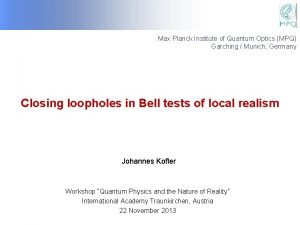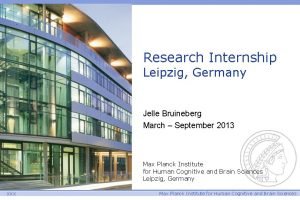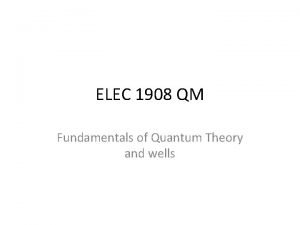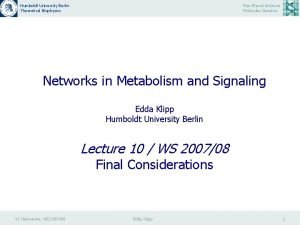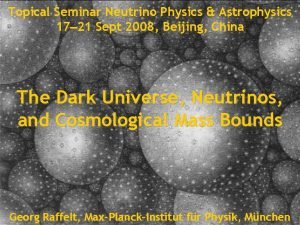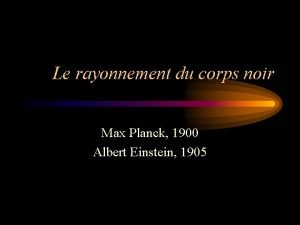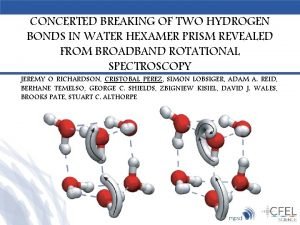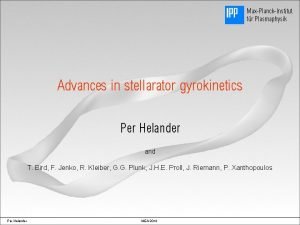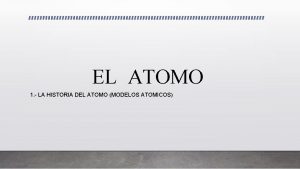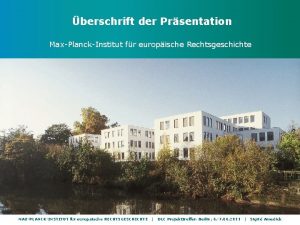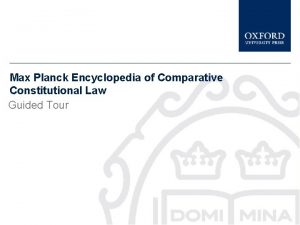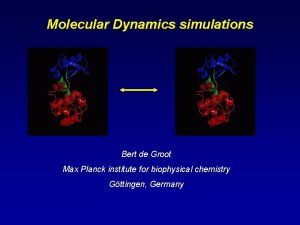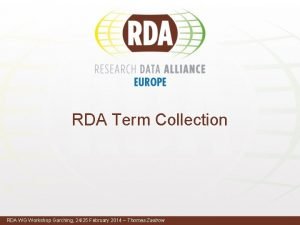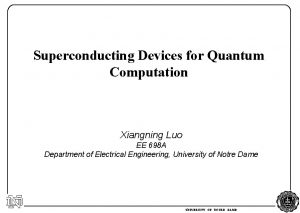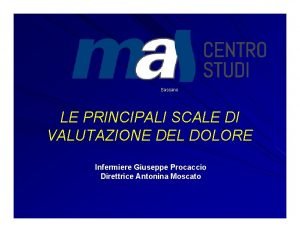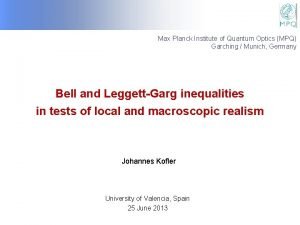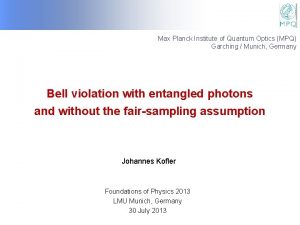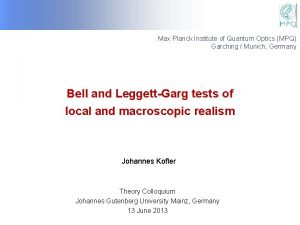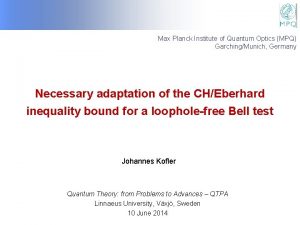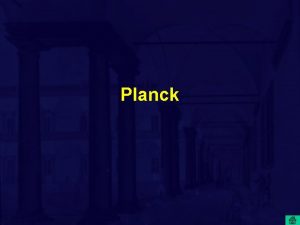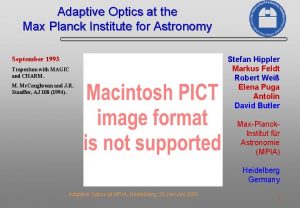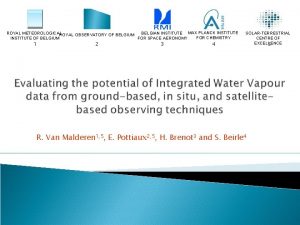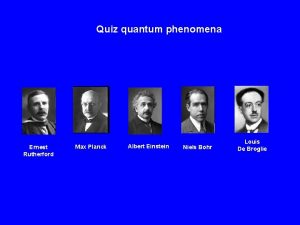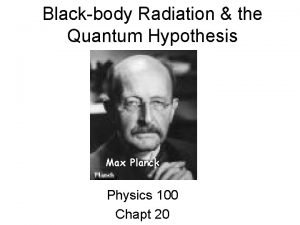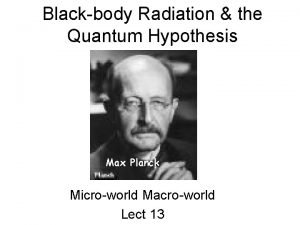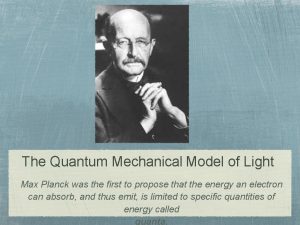Max Planck Institute of Quantum Optics MPQ Garching

















- Slides: 17

Max Planck Institute of Quantum Optics (MPQ) Garching / Munich, Germany Photonic Bell violation closing the fair-sampling loophole Johannes Kofler Workshop “Quantum Information & Foundations of Quantum Mechanics” University of British Columbia, Vancouver, Canada 3 July 2013

Overview • Assumptions in Bell’s theorem - Realism - Locality - Freedom of choice • Closing loopholes - Locality - Freedom of choice - Fair sampling • Conclusion and outlook

History Quantum mechanics and hidden variables 1927 Kopenhagen interpretation (Bohr, Heisenberg) 1932 von Neumann’s (wrong) proof of non-possibility of hidden variables 1935 Einstein-Podolsky-Rosen paradox 1952 De Broglie-Bohm (nonlocal) hidden variable theory 1964 Bell‘s theorem on local hidden variables 1972 First successful Bell test (Freedman & Clauser) Bohr and Einstein, 1925

Local realism Classical world view: • Realism: physical properties are (probabilistically) defined prior to and independent of measurement • Locality: no physical influence can propagate faster than the speed of light External world Passive observers

Bell’s assumptions Assumptions Bell’s λ 1 Realism: Hidden variables determine global prob. distrib. : p(Aa 1 b 1, Aa 1 b 2, Aa 2 b 1, …|λ) 2 Locality: (OI) Outcome independence: p(A|a, b, B, λ) = p(A|a, b, λ) & vice versa for B (SI) Setting independence: p(A|a, b, λ) = p(A|a, λ) & vice versa for B 3 Freedom of choice: p(a, b|λ) = p(a, b) p(λ|a, b) = p(λ) J. F. Clauser and A. Shimony, Rep. Prog. Phys. 41, 1881 (1978) 3 J. S. Bell, Speakable and Unspeakable in Quantum Mechanics, p. 243 (2004) 1 2 J. S. Bell, Physics 1, 195 (1964)

Bell’s Assumptions theorem Realism + Locality + Freedom of choice Bell‘s inequality CHSH form 1: Sexp : = E(a 1, b 2) + E(a 2, b 1) – E(a 2, b 2) 2 Original Bell paper 2 implicitly assumed freedom of choice: explicitly: A(a, b, B, λ) locality (outcome and setting independence) freedom of choice implicitly: (λ|a, b) A(a, λ) B(b, λ) – (λ|a, c) A(a, λ) B(c, λ) 1 2 J. F. Clauser, M. A. Horne, A. Shimony, and R. A. Holt, PRL 23, 880 (1969) J. S. Bell, Physics 1, 195 (1964)

Loopholes: Why important? maintain local realism despite Sexp > 2 - quantum foundations - security of entanglement-based quantum cryptography Three main loopholes: • Locality loophole hidden communication between the parties closed for photons (19821, 19982) • Freedom-of-choice loophole settings are correlated with hidden variables closed for photons (20103) • Fair-sampling loophole measured subensemble is not representative E closed for atoms (20014), superconducting qubits (20095) and for photons (20136) A. Aspect et al. , PRL 49, 1804 (1982) 2 G. Weihs et al. , PRL 81, 5039 (1998) 3 T. Scheidl et al. , PNAS 107, 10908 (2010) 1 M. A. Rowe et al. , Nature 409, 791 (2001) M. Ansmann et al. , Nature 461, 504 (2009) 6 M. Giustina et al. , Nature 497, 227 (2013) 4 5

Locality & freedom of choice Tenerife b, B La Palma E, A a E La Palma Tenerife Locality: A is space-like sep. from b and B B is space-like sep. from a and A p(A, B|a, b, ) = p(A|a, ) p(B|b, ) Freedom of choice: a and b are random a and b are space-like sep. from E p(a, b| ) = p(a, b) T. Scheidl, R. Ursin, J. K. , T. Herbst, L. Ratschbacher, X. Ma, S. Ramelow, T. Jennewein, A. Zeilinger, PNAS 107, 10908 (2010)

Results Coincidence rate detected: 8 Hz Measurement time: 2400 s Number of total detected coinc. : 19200 Polarizer settings a, b 0°, 22. 5° 0, 67. 5° 45°, 22. 5° 45°, 67. 5° Correlation E(a, b) 0. 62 ± 0. 01 0. 63 ± 0. 01 0. 55 ± 0. 01 – 0. 57 ± 0. 01 Obtained Bell value Sexp 2. 37 ± 0. 02 T. Scheidl, R. Ursin, J. K. , T. Herbst, L. Ratschbacher, X. Ma, S. Ramelow, T. Jennewein, A. Zeilinger, PNAS 107, 10908 (2010)

Fair-sampling loophole Unfair sampling: detection efficiency could be low and setting-dependent 1 A = A( , ), B = B( , ) • Simple local realistic model 2: Reproduces the quantum predictions and has correct ratio of singles, coincidences and no clicks at all • Efficiency is not optional in security-related tasks (device-independent quantum cryptography): faked Bell violations 3 P. M. Pearle, PRD 2, 1418 (1970) 2 N. Gisin and B. Gisin, Phys. Lett. A 260, 323 (1999) 3 I. Gerhardt, Q. Liu, A. Lamas-Linares, J. Skaar, V. Scarani, V. Makarov, C. Kurtsiefer, PRL 107, 170404 (2011) 1

Eberhard inequality • CHSH inequality requires tot > 82. 8 %1 (max. entangled states) • Eberhard 2 (CH 3) inequality requires tot > 66. 7 % - no fair-sampling assumption - no requirement to measure tot - no post-selection or normalization - only one detector per side (non-max. ent. states) Source A. Garg and N. D. Mermin, PRD 35, 3831 (1987) 2 P. H. Eberhard, PRA 47, 747 (1993) 3 J. F. Clauser and M. A. Horne, PRD 10, 526 (1974) 1 local realism

Transition-edge sensors Working principle: • Superconductor ( 200 nm thick tungsten film at 100 m. K) at transition edge • Steep dependence of resistivity on temperature • Measurable temperature change by single absorbed photon Characteristics: • High efficiency > 95 %1 • Low noise < 10 cps 1 • Photon-number resolving 1 2 Picture from: Topics in Applied Physics 99, 63 -150 (2005) A. E. Lita, A. J. Miller, S. W. Nam, Opt. Express 16, 3032 (2008) Superconducting transition-edge sensors 1

Setup • Sagnac-type entangled pair source • Non-max. entangled states • Fiber-coupling efficiency >90% • Filters: backgroundphoton elimination >99% M. Giustina, A. Mech, S. Ramelow, B. Wittmann, J. K. , J. Beyer, A. Lita, B. Calkins, T. Gerrits, S. W. Nam, R. Ursin, A. Zeilinger, Nature 497, 227 (2013)

Results Coo(α 1, β 1) Coo(α 1, β 2) Coo(α 2, β 1) Coo(α 2, β 2) So. A(α 1) So. B(β 1) J 1069306 1152595 1191146 69749 1522865 1693718 – 126715 • Violation of Eberhard’s inequality • 300 seconds per setting combination • Detection efficiency tot 75% • No background correction etc. Photon: only system for which all main loopholes are now closed (not yet simultaneously) M. Giustina, A. Mech, S. Ramelow, B. Wittmann, J. K. , J. Beyer, A. Lita, B. Calkins, T. Gerrits, S. W. Nam, R. Ursin, A. Zeilinger, Nature 497, 227 (2013)

The fair-sampling team Marissa Giustina Alexandra Mech Bernhard Wittmann Sven Ramelow Jörn Beyer Adriana Lita Brice Calkins Thomas Gerrits Sae Woo Nam Rupert Ursin Anton Zeilinger

Conclusion and outlook • Loopholes important for quantum foundations & quantum cryptography • Locality and freedom-of-choice loophole closed for photons • Fair-sampling loophole (already closed for atoms and superconducting qubits) now closed for photons • Photons: first system for which each of the three major loopholes has been closed, albeit in separate experiments • For a loophole-free experiment: fast random number generators, precise timing, efficiency gains to compensate propagation losses due to increased distance • Endgame for local realism has begun

Appendix: Bell vs. Leggett-Garg J. K. and Č. Brukner, PRA 87, 052115 (2013)
 Mpq garching
Mpq garching Jelle bruineberg
Jelle bruineberg Difference between ray optics and wave optics
Difference between ray optics and wave optics Reflection and refraction venn diagram
Reflection and refraction venn diagram Xkcd exponential
Xkcd exponential Max planck
Max planck Max planck
Max planck 1900 max planck
1900 max planck Max planck
Max planck Gyrokinetic
Gyrokinetic La historia del átomo
La historia del átomo Max planck institut rechtsgeschichte
Max planck institut rechtsgeschichte Max planck encyclopedia of comparative constitutional law
Max planck encyclopedia of comparative constitutional law Bert de groot
Bert de groot Garching wg
Garching wg Superconducting devices in quantum optics
Superconducting devices in quantum optics Scala vrs
Scala vrs Classical mechanics
Classical mechanics
